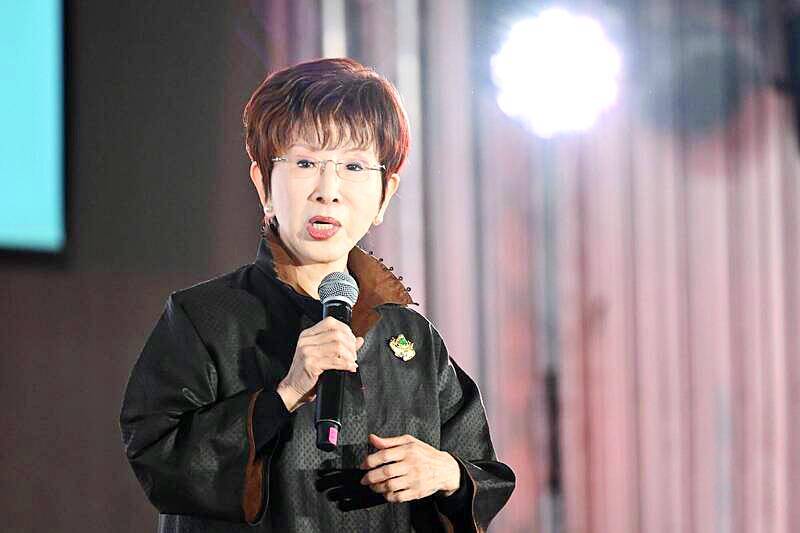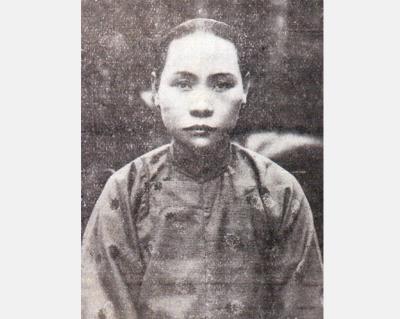Former Chinese Nationalist Party (KMT) chairwoman Hung Hsiu-chu’s (洪秀柱) attendance at the Chinese Communist Party’s (CPP) “Chinese People’s War of Resistance Against Japanese Aggression and the World Anti-Fascist War” parade in Beijing is infuriating, embarrassing and insulting to nearly everyone in Taiwan, and Taiwan’s friends and allies.
She is also ripping off bandages and pouring salt into old wounds.
In the process she managed to tie both the KMT and the Democratic Progressive Party (DPP) into uncomfortable knots.

TT file photo
The KMT continues to honor their heroic fighters, who defended China against the invading Japanese Empire, which inflicted unimaginable horrors on the people of the Republic of China (ROC).
The CCP’s parade and accompanying propaganda are intended to rewrite the history of the war to portray the CCP as at the center of the fight, downplaying the innumerable sacrifices the ROC soldiers endured during that war. They are also portraying themselves as at the center of creating the post-war era institutions that include the UN, when in fact it was the ROC sitting at those tables.
That Hung would be at an event glorifying the CCP as the victor of the war must have caused the blood of descendants of those soldiers in Taiwan to run cold.
Hung added insult to injury by claiming that without the resistance of the “entire nation” (meaning the united front of the CCP and KMT), the ROC could not have survived, a wildly inaccurate claim. The CCP were bit players.
No wonder Taipei Mayor Chiang Wan-an (蔣萬安), the great-grandson of then ROC leader Chiang Kai-shek (蔣介石), coldly replied “I would not have gone” when asked about her attendance.
There is debate about whether to label the KMT as “China-leaning,” “China-friendly” or “pro-China.” By definition, anyone joining the KMT as a party member is “pro-China,” and endorses the view that Taiwanese are Chinese and that Taiwan is a province of China. Their stance is transparent: “Chinese” is right there in the name of the party.
In practice, the KMT is a broad tent party with many views on the subject. Some are anti-CCP and would fight to defend the ROC to the death. Many would like to see better relations with China, but have no interest in being ruled by the CCP.
Hung is extreme — she is overtly pro-CCP. She frequently visits China, praises the CCP, advocates for “reunification” and even praises the CCP’s cruel repression of the Uighurs.
OWN GOAL
Though her actions are offensive and insulting to many in the party, she presents a political problem of their own making. They can not outright criticize her trip without putting themselves in a trap.
The problem is that the KMT elected her as chairwoman. She was seen as an inconsequential short-term caretaker during a non-election period. It was also an apologetic consolation prize for voting overwhelmingly to oust her as the party’s presidential candidate in 2015.
They did not realize the long-term complications and embarrassments this would create for the party.
Hung’s pro-CCP stances have been used frequently in CCP United Front Work Department (UFWD) messaging. With their distorted messaging on how democracy works, they frequently portray “Taiwanese compatriots” as being subjugated by radical “DPP successionists,” implying that Hung represents the KMT, and by extension, her views are those of that downtrodden majority.
Hung’s actions and CCP ties are ballot box poison in national elections. It raises the uncomfortable question: if she is so extreme and pro-CCP, why did the KMT elect her in the first place?
Party leaders can now only grit their teeth and politely distance themselves, saying she “no longer” represents the party and is acting in a “personal” capacity. Current Chairman Eric Chu (朱立倫) can only beseech her to “follow the law,” by which he hopes she will not say anything outright treasonous.
The KMT has tried to convince both voters and key foreign nations — such as the US and Japan — that they can be trusted to protect Taiwan’s sovereignty and adequately provide for Taiwan’s defense.
Hung, as the former elected leader of Taiwan’s largest opposition party, giving the CCP “face” and their big parade on the world stage featuring Xi Jinping (習近平) flanked by his honored guests North Korean leader Kim Jong-un and Russian President Vladimir Putin, makes it hard for the KMT to convince people they are staunch allies standing against CCP hegemony.
Chiang Kai-shek must be spinning in his grave.
Even former President Ma Ying-jeou (馬英九), whose own frequent trips to China and comments cause considerable consternation, recognized that attending this CCP showpiece event was a step too far.
TYING BOTH PARTIES IN KNOTS
Hung’s attendance also creates headaches and embarrassment for the ruling DPP administration. They must convince international friends and allies that Taiwan, regardless of which party is in charge, can be trusted as an ally and that supporting Taiwan is not a wasted effort.
It must be painful for DPP leaders to work towards getting advanced weapons systems and rally support for Taiwan’s cause while insisting that the military will remain strong and loyal, even if the KMT returns to power. They are in the awkward position of having to defend the KMT, a task that Hung seems determined to make as difficult as she can.
In a signed article in May, Xi wrote that Taiwan’s restoration to China is a victorious outcome of World War II and an integral part of the postwar international order. Hung referred to the “war of resistance (against Japan) as a “memory common to all the people (of the Chinese nation).”
These two comments touch on uncomfortable history for both sides of the political spectrum.
Hung implies that the memory of the war is shared by all “Chinese,” which to her includes Taiwanese.
The uncomfortable truth is that during the war Taiwan was part of the Japanese Empire, and aside from a handful joining the Chinese side, the vast majority of Taiwanese involved in the war were in the Imperial Japanese armed forces. The memories of the war in Taiwan are vastly different than those arriving from China.
The DPP has roots in the movements following the 228 Incident, when Taiwanese led an uprising against the recently arrived KMT troops in 1947. Those KMT troops were involved in systematic looting and violence, often at the behest of the government to feed the civil war effort in China, but in many cases it was personal.
That is a side of the story neither the KMT nor the DPP likes to discuss.
Many of those KMT troops were engaging in personal revenge against the Taiwanese for the atrocities of the Japanese in China. The Taiwanese spoke Japanese, dressed in Japanese style and were on the Japanese side.
That many Taiwanese, who previously disliked being second-class citizens under the Japanese, disliked the KMT even more was infuriating to the newcomers. They systematically destroyed as much Japanese influence as they could and worked to replace it with a Chinese identity.
The DPP, who historically have ties to the majority population of Taiwanese Hoklo speakers living in Taiwan prior to the arrival of the KMT and the Chinese Civil War refugees, are not keen to be associated with supporting the Japanese colonialists and being on their side in the war. They are generally more positive towards the Japanese to this day, but discussing Taiwan’s role during the war is a topic they carefully avoid.
Hung’s statements and actions infuriated people from across the political spectrum, leaving them squirming and unable to adequately respond.
Not the KMT, not the DPP.
The only points scored were for her friends in the CCP.
Donovan’s Deep Dives is a regular column by Courtney Donovan Smith (石東文) who writes in-depth analysis on everything about Taiwan’s political scene and geopolitics. Donovan is also the central Taiwan correspondent at ICRT FM100 Radio News, co-publisher of Compass Magazine, co-founder Taiwan Report (report.tw) and former chair of the Taichung American Chamber of Commerce. Follow him on X: @donovan_smith.

Dec. 8 to Dec. 14 Chang-Lee Te-ho (張李德和) had her father’s words etched into stone as her personal motto: “Even as a woman, you should master at least one art.” She went on to excel in seven — classical poetry, lyrical poetry, calligraphy, painting, music, chess and embroidery — and was also a respected educator, charity organizer and provincial assemblywoman. Among her many monikers was “Poetry Mother” (詩媽). While her father Lee Chao-yuan’s (李昭元) phrasing reflected the social norms of the 1890s, it was relatively progressive for the time. He personally taught Chang-Lee the Chinese classics until she entered public

Last week writer Wei Lingling (魏玲靈) unloaded a remarkably conventional pro-China column in the Wall Street Journal (“From Bush’s Rebuke to Trump’s Whisper: Navigating a Geopolitical Flashpoint,” Dec 2, 2025). Wei alleged that in a phone call, US President Donald Trump advised Japanese Prime Minister Sanae Takaichi not to provoke the People’s Republic of China (PRC) over Taiwan. Wei’s claim was categorically denied by Japanese government sources. Trump’s call to Takaichi, Wei said, was just like the moment in 2003 when former US president George Bush stood next to former Chinese premier Wen Jia-bao (溫家寶) and criticized former president Chen

Politics throughout most of the world are viewed through a left/right lens. People from outside Taiwan regularly try to understand politics here through that lens, especially those with strong personal identifications with the left or right in their home countries. It is not helpful. It both misleads and distracts. Taiwan’s politics needs to be understood on its own terms. RISE OF THE DEVELOPMENTAL STATE Arguably, both of the main parties originally leaned left-wing. The Chinese Nationalist Party (KMT) brought together radicals, dissidents and revolutionaries devoted to overthrowing their foreign Manchurian Qing overlords to establish a Chinese republic. Their leader, Sun Yat-sen

Late one night in April 2020, towards the start of the COVID lockdowns, Shanley Clemot McLaren was scrolling on her phone when she noticed a Snapchat post by her 16-year-old sister. “She’s basically filming herself from her bed, and she’s like: ‘Guys you shouldn’t be doing this. These fisha accounts are really not OK. Girls, please protect yourselves.’ And I’m like: ‘What is fisha?’ I was 21, but I felt old,” she says. She went into her sister’s bedroom, where her sibling showed her a Snapchat account named “fisha” plus the code of their Paris suburb. Fisha is French slang for